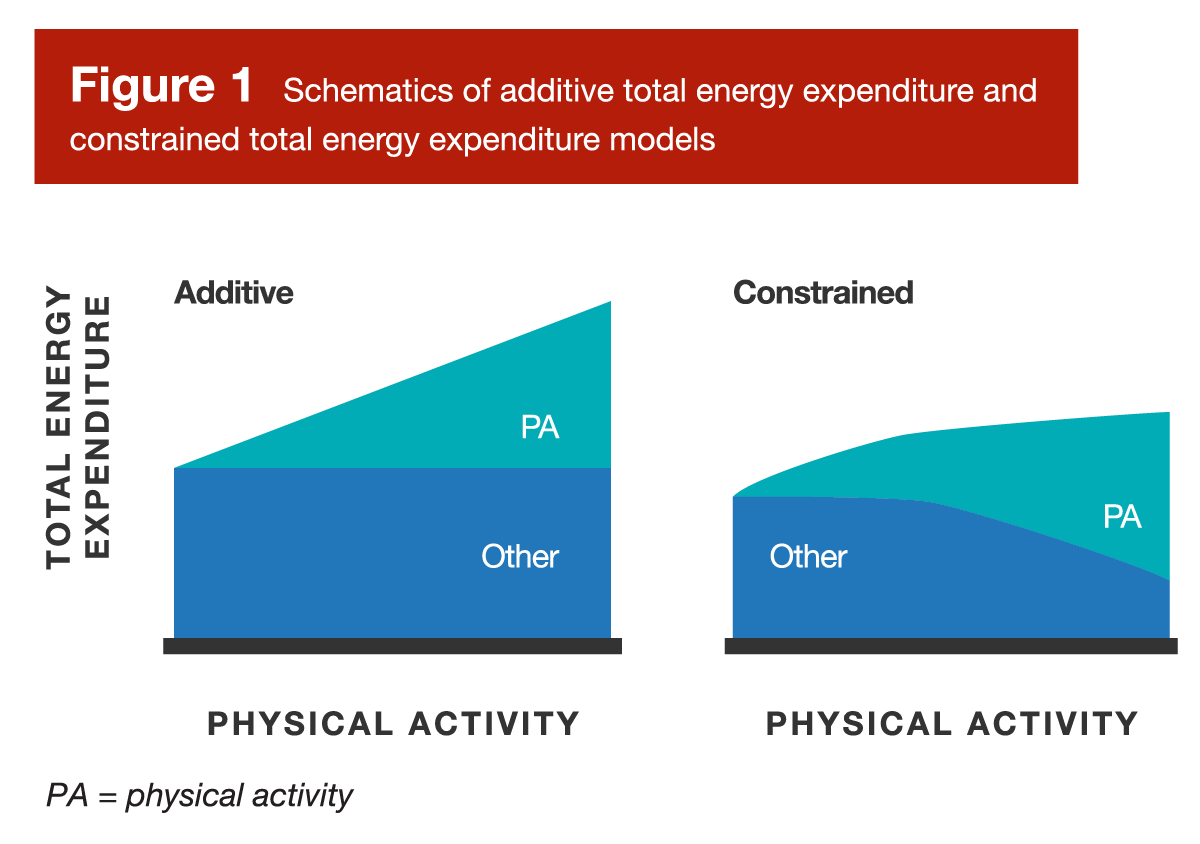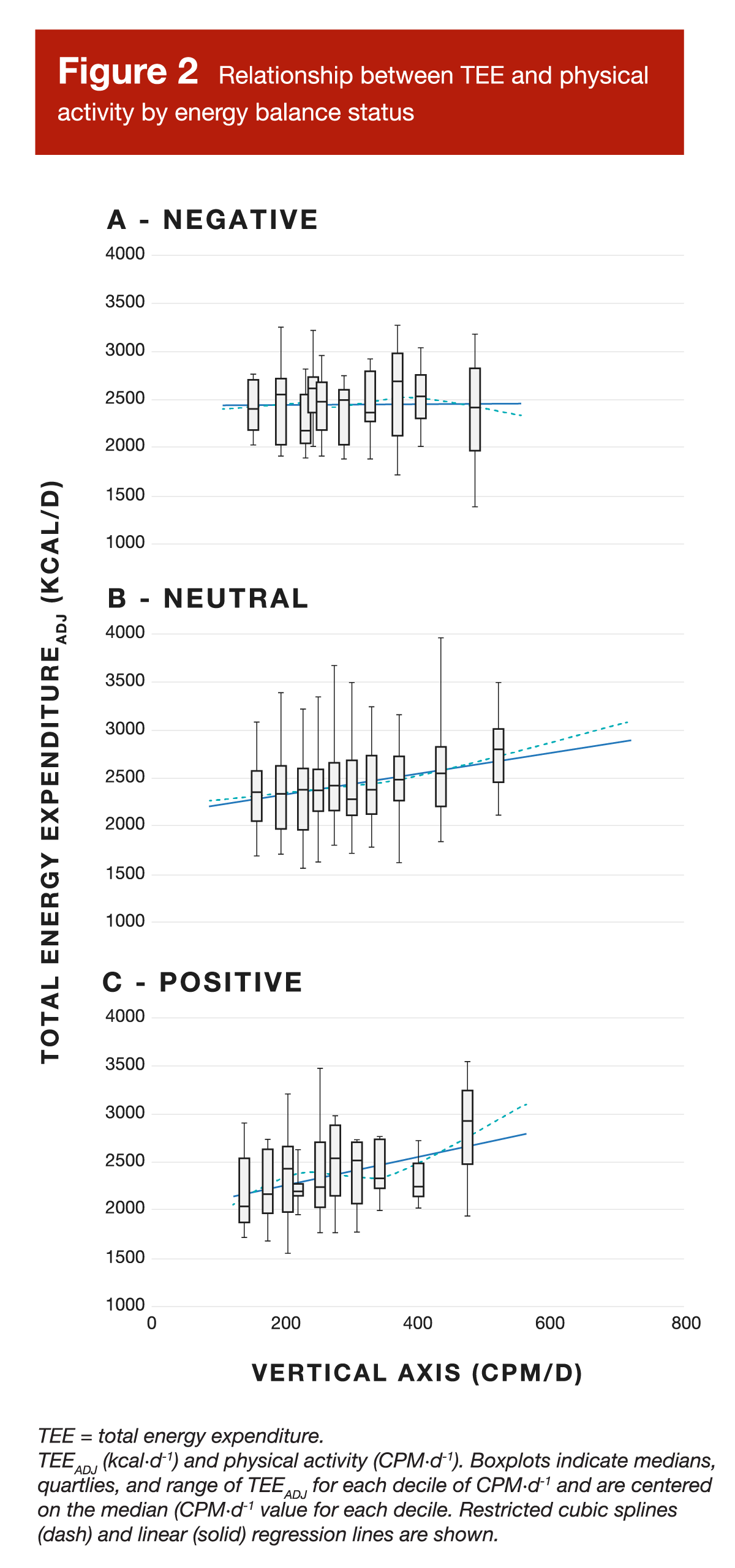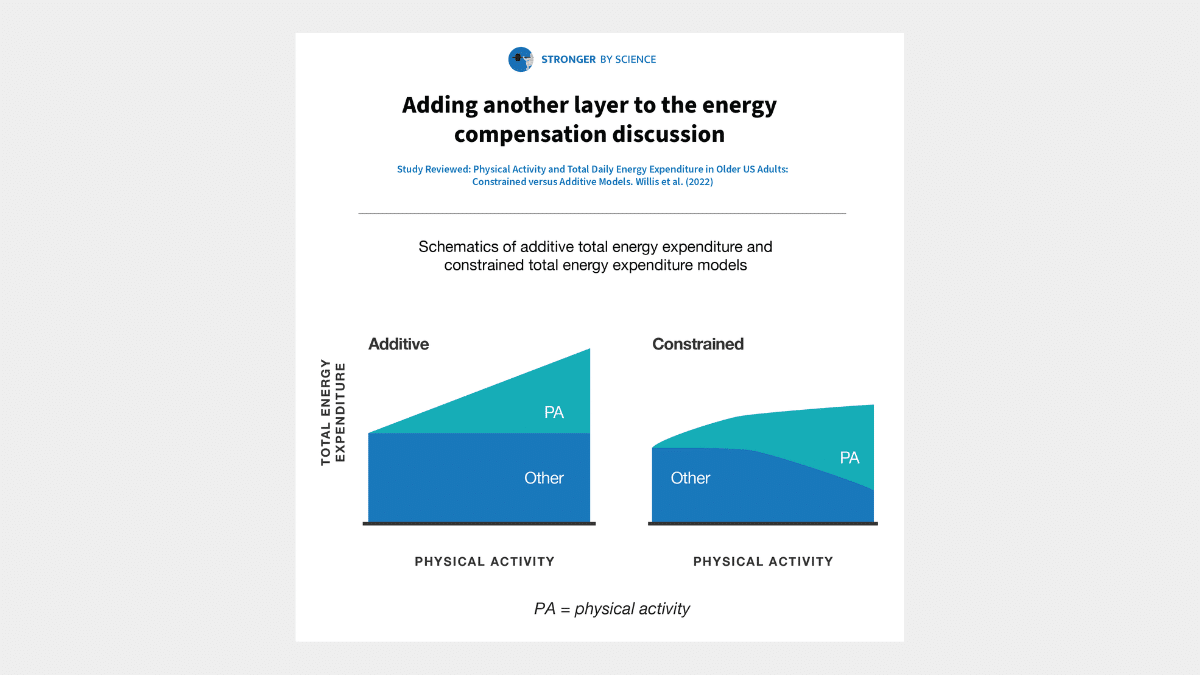The constrained total energy expenditure model isn’t new, but it’s definitely a hot topic at the moment. Pontzer et al published a very thorough overview of the concept back in 2016, but a few newer papers have made quite a splash over the past year or so. A paper by Careau et al reported (in a huge sample of free-living individuals) that people tend to compensate for increased physical activity by reducing basal energy expenditure. There was also the paper by Broskey et al, which Dr. Helms reviewed in MASS, that also identified compensatory reductions in non-exercise components of energy expenditure, ultimately resulting in lower-than-predicted weight loss over the course of an exercise intervention. More recently, Dr. Kevin Hall revisited the data from the Biggest Loser Study (reviewed here) to present an updated perspective, suggesting that the observation of large, sustained, unexpected suppression of resting metabolic rate could be related to compensatory adjustments in response to high levels of physical activity.
As the constrained energy expenditure model picks up steam, it’s informative to frame (and assess) it relative to the alternative model – the additive energy expenditure model. The additive model is certainly the most parsimonious; it contends that when we add 100kcals worth of exercise to our daily routine, total daily energy expenditure increases by roughly 100kcals. The constrained model argues that things are a bit more complicated – when baseline physical activity level is on the lower end of the spectrum, the constrained model and additive model essentially agree that total daily energy expenditure increases fairly proportionally to the amount of extra exercise that is added to the mix. However, the models diverge at higher levels of physical activity; the additive model assumes that the increases in energy expenditure keep ramping up, whereas the constrained model assumes that our bodies make adaptive adjustments to constrain total daily energy expenditure within a working range. In other words, as we start pushing total daily energy expenditure up to potentially unsustainable levels by engaging in extremely high levels of physical activity, our body aims to become more energy efficient, cutting unnecessary energy expenditure from other processes taking place at rest. These models are concisely described in the following figure, adapted from a paper by Pontzer et al.

One important aspect of Figure 1 is that energy compensation in the constrained model is incomplete. In other words, as you move from low physical activity levels to high levels, there is still a general increase in total energy expenditure. Physical activity increases total energy expenditure, but not quite as much as you’d expect, particularly at higher levels of activity. Many people misinterpret the constrained model and suggest that exercise is totally useless for increasing total energy expenditure. However, based on the assumption of partial energy compensation, a more accurate interpretation of the proposed model is that exercise causes smaller increases in total energy expenditure than you would mathematically anticipate.
The presently reviewed study put the constrained model to the test by directly comparing it to the additive model. In 584 free-living American adults (between the ages of 50-74 years, with BMI values between 18.5-40 kg/m2), total energy expenditure was measured using doubly labeled water, and physical activity was measured using accelerometry. The 12-month study timeline included a complicated staggering of assessments, but the important highlights are that total energy expenditure was measured over a 14-day period, physical activity was measured over a 7-day period, and energy status was categorized based on average weight change over a six-month period. Positive energy balance was defined as gaining more than 3% of body weight, negative energy balance was defined as losing more than 3% of body weight, and neutral energy balance was defined as staying within ±3% of baseline weight. The simplified version of the results is very straightforward: for people in neutral or positive energy balance, the additive model did just fine – as physical activity went up, total energy expenditure went up to a fairly proportional degree. However, the constrained model held true for people in negative energy balance; total energy expenditure was fairly stable across the full range of activity levels. These relationships are presented in Figure 2.

This is pretty cool. In a recent MASS article, we saw how the constrained model can help us understand the adaptations commonly attributed to negative energy balance. In this paper, we see how negative energy balance can help us understand the constrained model. As a result, we have even more evidence supporting the idea that these two topics (metabolic adaptation and the constrained model) are inherently linked under the umbrella of topics related to energy availability. Of course, we should always hesitate to get overly excited about a singular research finding (pending further verification and replication), but these results might fill a pretty important gap in our understanding of energy compensation. Overly simplistic interpretations of the constrained energy expenditure concept have always bothered me, because they don’t seem to pass some very superficial, unscientific sanity checks. We never want to get too attached to our anecdotal observations (as they are susceptible to considerable subjectivity and misinterpretation), but we also don’t want to ignore our experience and observations. Overly simplistic interpretations of the constrained model just don’t seem to match up with reality.
When people suggest that energy expenditure is maintained within an extremely tight range to compensate for physical activity, they often lean on studies showing surprisingly similar total daily energy expenditure in people with sedentary lifestyles in more industrialized areas compared to people who perform energy-intensive physical work in less industrialized areas. However, it is difficult to reconcile this with the research reporting that energy expenditure fluctuations across the adult lifespan seem mostly tied to changes in physical activity or the research indicating that total daily energy expenditure in free-living athletes tends to be markedly higher than in free-living non-athletes.
Beyond that, I tend to be pretty curious about physiology, and I’ve spent most of my life hanging around a mixture of people with athletic goals and body composition goals. I’ve long been frustrated by an apparent discrepancy: I’ve known plenty of endurance athletes who seem to perpetually achieve astonishingly high caloric intakes to fuel their training, but I’ve simultaneously known plenty of chronic dieters who seem to require surprisingly low caloric intakes to promote further weight loss, despite pretty eye-popping amounts of daily cardio. I’ve never really resisted the concept of energy compensation, but I’ve long suspected that compensation is relatively incomplete in the majority of contexts, and that the relationship between physical activity level and the degree of compensation contains multiple layers of complexity.
Thanks to the hard work of many researchers, we are continuing to develop a more nuanced understanding of those layers of complexity. For starters, the relative degree of physical activity should influence the magnitude of compensation – it’s literally built into the model (see Figure 1), which assumes that more severe compensation doesn’t kick in until physical activity levels get pretty high. In addition, there appears to be considerable variability between individuals; in the study by Careau et al, higher fat mass was predictive of greater energy compensation. To quantify this relationship in practical terms, they reported that leaner individuals at the 10th BMI percentile compensated for 29.7% of the calories burned during physical activity, whereas individuals at the 90th BMI percentile compensated for 45.7%. It’s unclear if compensation leads to greater BMI or if greater BMI leads to more compensation (or if a more complicated relationship explains the link between BMI and compensation), but there appears to be significant inter-individual variability that correlates with BMI (and more specifically, fat mass).
To add to the complexity, the presently reviewed study suggests that compensation is also impacted by the energy status of the individual. This may help us understand why total energy expenditure could be similar when we compare people in more active, less industrialized areas (where excess energy consumption is less likely) to people in less active, more industrialized areas (where excess energy consumption is more likely). It may also help us understand why the chronic dieter appears to experience so much energy expenditure compensation for their countless hours on the treadmill, while we observe consistently high energy expenditure values in endurance athletes who are actively striving to adequately fuel their training efforts.
As this line of research pushes forward at an impressive pace, it has delivered some pretty useful observations. We can’t treat cardio as a one-size-fits-all method for increasing energy expenditure, and we should be open to the idea that some individuals will experience more or less compensation, depending on the circumstances. Aside from variability that is inherent to the individual (which may correlate with higher fat mass), individuals might experience greater degrees of compensation as they reach fairly high levels of physical activity or achieve fairly low levels of energy availability. So, exercise can absolutely be part of a well-constructed weight loss program (in addition to countless other benefits), but the relative efficiency with which exercise boosts total daily energy expenditure is context-dependent.
This Research Spotlight was originally published in MASS Research Review. Subscribe to MASS to get a monthly publication with breakdowns of recent exercise and nutrition studies.
Credit: Graphics by Kat Whitfield.




